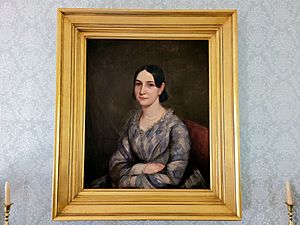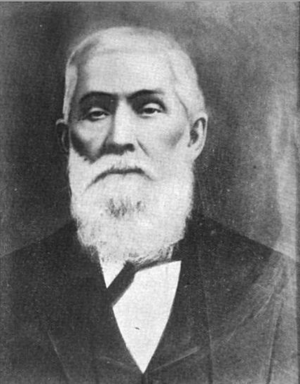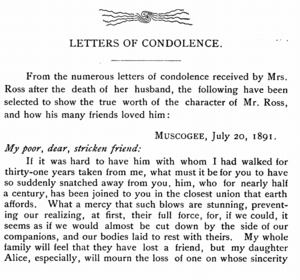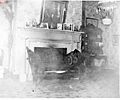Mary Jane Ross facts for kids
Quick facts for kids
Mary Jane Ross
|
|
|---|---|

Portrait of Mary Jane Ross hanging in the West Bedroom of Hunter's Home, Park Hill, Oklahoma
|
|
| Born | November 5, 1827 Tennessee, U.S.
|
| Died | July 29, 1908 (aged 80) |
| Resting place | Cherokee National Cemetery, Fort Gibson, Muskogee County, Oklahoma, U.S. |
| Nationality | Cherokee |
| Alma mater | Patapsco Female Institute |
|
Notable work
|
The Life and Times of Honorable William P. Ross of the Cherokee Nation (1893) |
| Spouse(s) | William P. Ross (married 1846) |
Mary Jane "Mollie" Ross (November 5, 1827 – July 29, 1908) was an important member of the Cherokee Nation. She was born in Tennessee into the well-known Ross family. Her family played a big role in leading the Cherokee people through tough times, like the Trail of Tears and the American Civil War.
Mary Jane's uncle, John Ross, was the main chief of the Cherokee Nation for many years. Her father, Lewis Ross, was a successful businessman and the Treasurer for the Cherokee Nation. Mary Jane grew up with ten brothers and sisters. Even though her family was wealthy, she faced many challenges. She was forced to move during the Trail of Tears and lived through the difficulties of the Civil War. Mary Jane was very good at her studies and was a talented musician. She also helped care for Cherokee children who lost their parents after the war. Later in life, she wrote and edited a book about her husband.
Contents
Mary Jane's Education
Mary Jane Ross went to the Patapsco Female Institute in Ellicott City, Maryland. This school, started in 1837, was special because it offered advanced subjects to young women. Girls there could study botany (plants), chemistry, and mathematics. At that time, it was not common for girls to learn science and math.
Chief John Ross and Mary Jane's father, Lewis Ross, believed that education was very important for both Cherokee men and women. They thought that educating young people would help the tribe stay strong and successful for a long time. Mary Jane's brother, Henry C. Ross, also went away to school in Pennsylvania. Later, Mary Jane sent her own son, Willie Ross, to the same school during the Civil War.
Marriage and Family Life

In 1846, Mary Jane married her cousin, William Potter Ross. He later became a principal Chief of the Cherokee Nation. They had nine children together:
- William Dayton Ross (born 1848)
- Lewis Ross (born 1852, died at 11 months old)
- Martha Candiss Ross (born 1853)
- Emma Lincoln Ross (born 1854)
- Cora Ross (born 1856)
- George Murrell Ross (born 1859, died at 11 months old)
- Mary "Mamie" Ross (born 1863)
- Hubbard Ross (born 1867)
- Phillip S. Ross (born 1870)
In the book she helped write about her husband, Mary Jane shared details about their marriage. She wrote about their honeymoon trip, calling it "romantic." She also made sure to show how much William Potter Ross was loved by his friends, family, and the Cherokee Nation. She even included copies of personal letters people sent to her after he passed away. These personal touches helped readers understand him better.
Hunter's Home: A Historic Place
|
Hunter's Home
|
|

Hunter's Home
|
|
| Location | Park Hill, Oklahoma |
|---|---|
| Built | 1843–1845 |
| Architectural style | Federal |
| NRHP reference No. | 70000530 |
| Designated NHL | May 30, 1974 |
Much of the Ross family's story is connected to a large house called the Murrell Home or Hunter's Home. It is located in Park Hill, near Tahlequah, Oklahoma, in the Cherokee Nation. Mary Jane's brother-in-law, George M. Murrell, built the home between 1843 and 1845. Today, it is the only large plantation home from before the Civil War that is still standing in Oklahoma. Many others were burned or destroyed during the war.
Inside Hunter's Home, there is a piano from the 1840s that belonged to Mary Jane Ross. A painting of Mary Jane hangs in the West Bedroom, which is where she gave birth to her son, Hubbard Ross.
During the Civil War, the area around Hunter's Home was often attacked by soldiers from both the Union and Confederate armies. When the war started, George M. Murrell and his family left the home. George joined the Confederate Army. This might be why Confederate soldiers did not burn the house down. Mary Jane Ross even hid important Cherokee Nation documents inside the basement walls of the home to keep them safe.
Mary Jane wrote to her friend Sarah about how difficult life was during the war near Park Hill:
"For the last seven months the storm of war has howled so fearfully around us... It were vain for me to endeavor to picture to you the terrors and trials we have passed through... The people are starving-and the Small pox has broken out... Katy and I cook, wash, make fires, work in the garden and even work an old mule in the cart when we get out of wood..."
In October 1865, Mary Jane wrote to her son Willie about the condition of Hunter's Home after the war:
"Your Aunt Mankie's [Amanda's] house and place looks much worn and grown up with weeds. Inside the house, her nice side board was broken... and all the feathers spilt upon the floors and the ticks [mattresses] taken by Stand Watie's men. They treated Aunt Jane very badly indeed, took all her quilts and blankets - meat, flour, coffee, salt, corn and wheat that your Uncle George and Aunt Mankie gave her."
Mary Jane moved into Hunter's Home after the war because her own home in Fort Gibson was destroyed.
Becoming a Refugee
Even though Mary Jane's uncle, Chief John Ross, supported the Union, he signed a treaty with the Confederacy in September 1861. He did this to try and keep the Cherokee tribe from breaking apart even more. On July 15, 1862, Union soldiers came to Park Hill and arrested Chief Ross for signing the treaty. Mary Jane's husband was also arrested at this time.
Chief John Ross left Oklahoma with about thirty-five family members. William Potter Ross, Mary Jane Ross, and their daughters, Emma and Cora, went with the Chief's group. Their son, Willie, stayed at school in Pennsylvania. Mary Jane and her daughters became refugees in Fort Scott, Kansas. While in Kansas, Mary Jane wrote to her son Willie, who was still at school. In August 1863, she wrote about her worries for the future of the Cherokee Nation after her home in Fort Gibson was burned.
"Where we will find another home I cannot say, but I still intend to go back to the Nation, but whether there will be peace, safety, and pleasure living there for a long time to come is doubtful. At best things will be changed. Many of our friends have been scattered abroad upon the world. Others dead, yet others are estranged one from the other."
Mary Jane and William Potter Ross eventually returned to the Cherokee Nation when Union forces took control of the area.
Helping Cherokee Orphans
After the Civil War, many Cherokee children became orphans or had only one parent who had to travel to find work. Mary Jane and William Potter Ross worked to create a home for these children. In 1872, the Cherokee Nation started looking for places to build an orphanage. One idea was to use Mary Jane's family home, which had belonged to her father, Lewis Ross, who had passed away in 1860. This home was a large, three-story brick house that could be made bigger.
Remembering William P. Ross

Mary Jane's husband, William Potter Ross, died on July 20, 1891. He is buried in the Cherokee National Cemetery. In the two years after his death, Mary Jane worked hard to prepare, edit, and publish his life story, called "The Life and Times of Honorable William P. Ross of the Cherokee Nation" (1893).
She wrote a special message at the beginning of the book, thanking those who supported her.
"To his many friends in the Cherokee Nation and elsewhere who have honored him, and to his cousin, Joshua Ross, whose labors we so highly appreciate, is this volume respectfully dedicated by his wife, MRS. WM. P. ROSS."
Mary Jane received many letters and kind words after her husband's death. She decided to include some of these letters in the book. Her cousin, Jane Nave, sent a very personal letter on the day William died, showing how important he was to Mary Jane:
"Dear Cousin Mollie: The sad, the stunning news, came to me with a shock! Your irreparable loss; your companion and beloved husband taken from you, by the relentless hand of death! and, oh, how my deepest sympathies go out to you and your dear children in your heart-stricken grief and sorrow..."
Images for kids
See also
- Timeline of Cherokee removal
- Indian Removal Act






